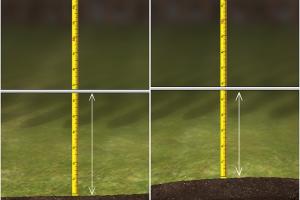Mastering the Art of Leveling Ground: A Comprehensive Guide for Homeowners

-
Quick Links:
- Introduction
- Why Level Ground?
- Tools Required for Ground Leveling
- Types of Ground Leveling Techniques
- Step-by-Step Guide to Leveling Ground
- Case Studies and Examples
- Expert Insights
- Common Mistakes to Avoid
- FAQs
Introduction
Leveling ground is a critical aspect of landscaping and site preparation that can drastically impact the functionality and aesthetics of your outdoor space. Whether you're planning to build a patio, a garden, or even a new structure, understanding how to properly level the ground is essential. In this comprehensive guide, we will delve into the methods, tools, and best practices for leveling ground, ensuring you have all the information you need to achieve a perfectly flat surface.
Why Level Ground?
Leveling ground serves several purposes, including:
- Drainage Improvement: Properly leveled ground prevents water pooling, which can lead to erosion and damage to plants.
- Foundation Stability: A level surface provides a solid foundation for structures, reducing the risk of settling or shifting.
- Aesthetic Appeal: A well-leveled yard or garden enhances its visual appeal, making it more enjoyable for you and your guests.
Tools Required for Ground Leveling
Before embarking on your ground leveling project, gather the following tools:
- Shovel
- Rake
- Level (spirit level or laser level)
- Stakes and string
- Tamper or compactor
- Wheelbarrow
- Excavator or bobcat (for larger projects)
Types of Ground Leveling Techniques
There are several techniques for leveling ground, each suited for different situations:
- Hand Leveling: Ideal for small areas, this method uses simple tools like shovels and rakes.
- Mechanical Leveling: For larger projects, machinery like excavators can efficiently move and grade soil.
- Laser Leveling: This advanced technique uses lasers to ensure precision, often employed in agricultural fields.
Step-by-Step Guide to Leveling Ground
Follow these steps to level your ground effectively:
Step 1: Assess the Area
Begin by evaluating the area you wish to level. Identify any slopes, depressions, or obstacles that may affect the leveling process.
Step 2: Mark the Boundaries
Using stakes and string, outline the area to be leveled. This will serve as a guide throughout the process.
Step 3: Remove Debris
Clear the designated area of any grass, rocks, and debris to provide a clean working surface.
Step 4: Level the Ground
Using your shovel and rake, start moving soil from higher areas to fill in lower spots. Use a level to check for evenness frequently.
Step 5: Compact the Soil
Once the ground is roughly level, use a tamper or compactor to compress the soil, preventing settling later on.
Step 6: Final Check
Perform a final check with your level to ensure the ground is evenly leveled before proceeding with any construction or landscaping.
Case Studies and Examples
To illustrate the importance and effectiveness of proper ground leveling, consider the following case studies:
Case Study 1: Residential Patio Construction
A homeowner looking to build a patio noticed water pooling in their yard after rain. By leveling the ground and creating a slight slope away from the home, they not only improved drainage but also provided a stable base for their patio.
Case Study 2: Community Garden Project
A local community garden faced issues with uneven plots, which hindered planting. After leveling the ground with a mechanical grader, the volunteers were able to create uniform garden beds that thrived throughout the season.
Expert Insights
We spoke with landscape professionals to gather their insights on the significance of proper ground leveling:
"A common mistake homeowners make is rushing the leveling process. Taking the time to assess and correctly level the ground can save a lot of headaches later on." - Jane Doe, Landscape Architect
Common Mistakes to Avoid
Here are some pitfalls to watch out for when leveling ground:
- Not checking for utilities before digging.
- Failing to compact the soil adequately.
- Ignoring drainage considerations.
FAQs
1. How do I know if my ground is level?
You can check for level using a spirit level or a laser level, ensuring the surface is even across your designated area.
2. Can I level ground without heavy machinery?
Yes, for small areas, hand tools like shovels and rakes can be effective.
3. What is the best time of year to level ground?
Spring or fall is ideal, as the soil is usually more workable and less prone to moisture issues.
4. How deep should I level the ground?
The depth depends on the project, but typically 4-6 inches is sufficient for most landscaping jobs.
5. Do I need a permit to level my ground?
It depends on local regulations; always check with your local authority before starting any ground leveling project.
6. What should I do with excess soil?
You can use excess soil for landscaping projects, fill in low spots elsewhere, or consider removing it if unnecessary.
7. How can I prevent my leveled ground from settling?
Compacting the soil thoroughly after leveling and maintaining proper drainage can help prevent settling.
8. Is it possible to level a sloped yard?
Yes, but it may require more extensive work and planning, including terracing or creating retaining walls.
9. What kind of soil is best for leveling?
A sandy-loam mixture is often the best choice, as it provides good drainage and compaction.
10. How long does it take to level ground?
The time required varies based on the size of the area and method used, but it can take anywhere from a few hours to a couple of days.
With this comprehensive guide, you are now equipped with the knowledge and skills needed to level ground efficiently and effectively. Whether for a small garden or a large construction project, proper ground leveling is a foundational step that sets the stage for success.
External References
- University of Minnesota Extension: Leveling Your Yard
- Federal Highway Administration: Guide to Leveling
- Houzz: Landscaping 101: How to Level a Yard
Random Reads